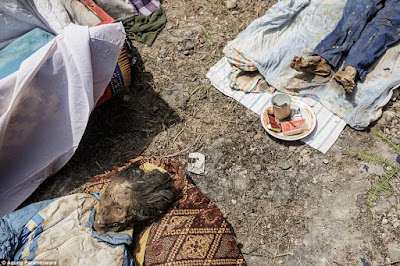Richard Barnett studied medicine before becoming a historian. His
writing has appeared in The Lancet, The London Magazine, and The Natural
Death Handbook. He is the author of Medical London: City of Diseases,
City of Cures and The Sick Rose.
Tuesday, November 24, 2015
Thursday, November 12, 2015
The Dead Babies' of Guatemala
Vultures
circle overhead as the decomposed bodies of babies are pulled from their
'final' resting places and thrown carelessly into plastic bags. Each
year, Guatemala City's cemetery workers use sledgehammers to break open
crypts belonging to babies and children, simply because their
poverty-stricken families can no longer afford the $24 rent on the plot. In
a heartbreaking series of images, photographer Saul Martinez sheds
light on the country's forgotten children destined for a mass grave at
the edge of the city's rubbish dump.
Six years
after the body of an adult or a child is laid to rest in the main
cemetery in Guatemala City - the capital of the Central American country
- relatives must pay $24 to cover the cost of the plot for four more
years. If
they are unable to pay, the crypts are smashed into and the coffins,
some tiny and decorated with white satin, are prized open. The
little corpses, still dressed in the clothes they were buried in or
swaddled in blankets, are ripped from the boxes and rolled into bundles. Grieving
relatives can collect the bodies, but often they are just wrapped in
plastic bags before being disposed of in a mass grave.
 |
| The decomposed body of a baby wrapped in the blanket |
 |
| A doll, bottle and blankets discarded after being removed from a coffin at Guatemala City cemetery |
 |
| Cemetery workers use sledgehammers to break into coffins removed from tombs. |
 |
| A cemetery worker holds the body of a baby in his arms after it was pulled from its tomb |
 |
| Maria Gomez received the remains of her son, who died in 1983. He was exhumed and moved to a cemetery closer to her home |
 |
| Tiny coffins, adorned with satin, are loaded on a wheelbarrow and as children's bodies are stuffed in plastic bags |
 |
| A girl reaches up to place flowers next to the crypts. |
 |
| The yellow and navy blue dress of a child who was buried at the cemetery is held up by one of the men who exhumed her. |
 |
| Tombs, which once contained loved ones, lie vacant |
 |
| Bodies are bagged up and unceremoniously dumped into a mass grave 40 meters down |
 |
| Vultures circle overhead as the bodies of babies are removed from their crypts and dumped in plastic bags at the cemetery. |
Photo series credit: Saul Martinez
via The Daily Mail
Wednesday, November 11, 2015
Ma'nene Ritual - Corpse Cleaning Part II
For every three years, in a bizarre ritual
which dates back hundreds of years, islanders pay respects to deceased
relatives by digging them up, cleaning their corpses and dressing them
in their favourite clothes. For the Torajan people, an ethnic group
indigenous to the mountainous region of Tana Toraja, the Ma'nene
festival is a celebration of life. The Ma'nene festival, translated to 'the Ceremony of Cleaning Corpses',
see the dead exhumed, groomed and dressed. It is a mark of respect to
strengthen bond between life and death. Their coffins are replaced
or fixed while relatives parade them around the village, following a
path of straight lines. They believe the paths connect them with Hyang, a
spiritual entity with supernatural power that only moves in straight
lines. The vast
majority of the 650,000 Torajan people are Christian or Muslim but a
small number still practice 'Aluk Todolo', or 'the Way of the
Ancestors'. The
funeral ritual is one of the most important and expensive events for
these communities and some Torajans save money their entire lives for a
decent burial.
All photos credit: Agung Parameswara
Via The Daily Mail
Monday, November 9, 2015
Skull Blessing in Bolivia Part II
The Day of the Skull takes place every year in Bolivia on November 8. They are decorated and taken to a cemetery in La Paz a week after All Saints Day. The skulls are cared for by the faithful who believe they give them protection. Some skulls are handed down through generations but many are taken from abandoned graves. The human skulls or 'natitas' are displayed outside the Cementario
General chapel in La Paz, Bolivia. They are surrounded by offerings of
coca leaves, flower petals and cigarettes. Many of the human skulls on show are kept in people's houses during the
year, and dusted off for the big day. They receive blessings and are
decorated with offerings.
 |
| Photo credit: Paul Koudounaris |
 |
| Photo credit: Paul Koudounaris |
 |
| Photo credit: Paul Koudounaris |
 |
| Photo credit: Paul Koudounaris |
 |
| Photo credit: Paul Koudounaris |
 |
| Photo credit: Paul Koudounaris |
 |
| Photo credit: Paul Koudounaris |
 |
| Photo credit: Paul Koudounaris |
 |
| Photo credit: Paul Koudounaris |
 |
| Photo credit: Paul Koudounaris |
 |
| Photo credit: Paul Koudounaris |
 |
| Photo credit: Paul Koudounaris |
 |
| Photo credit: Paul Koudounaris |
 |
| Photo credit: Paul Koudounaris |
You can see Part I here
Subscribe to:
Comments (Atom)








































